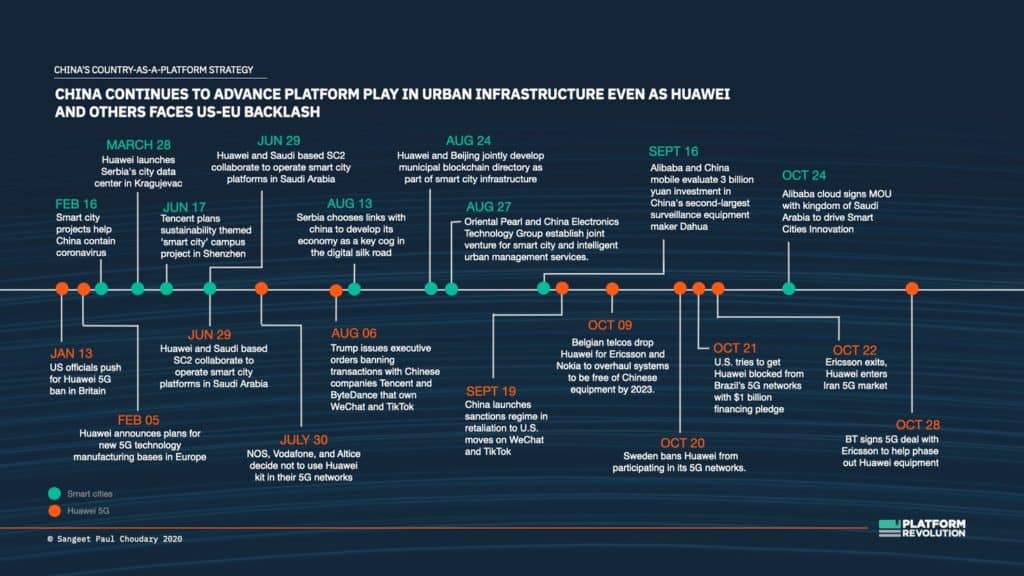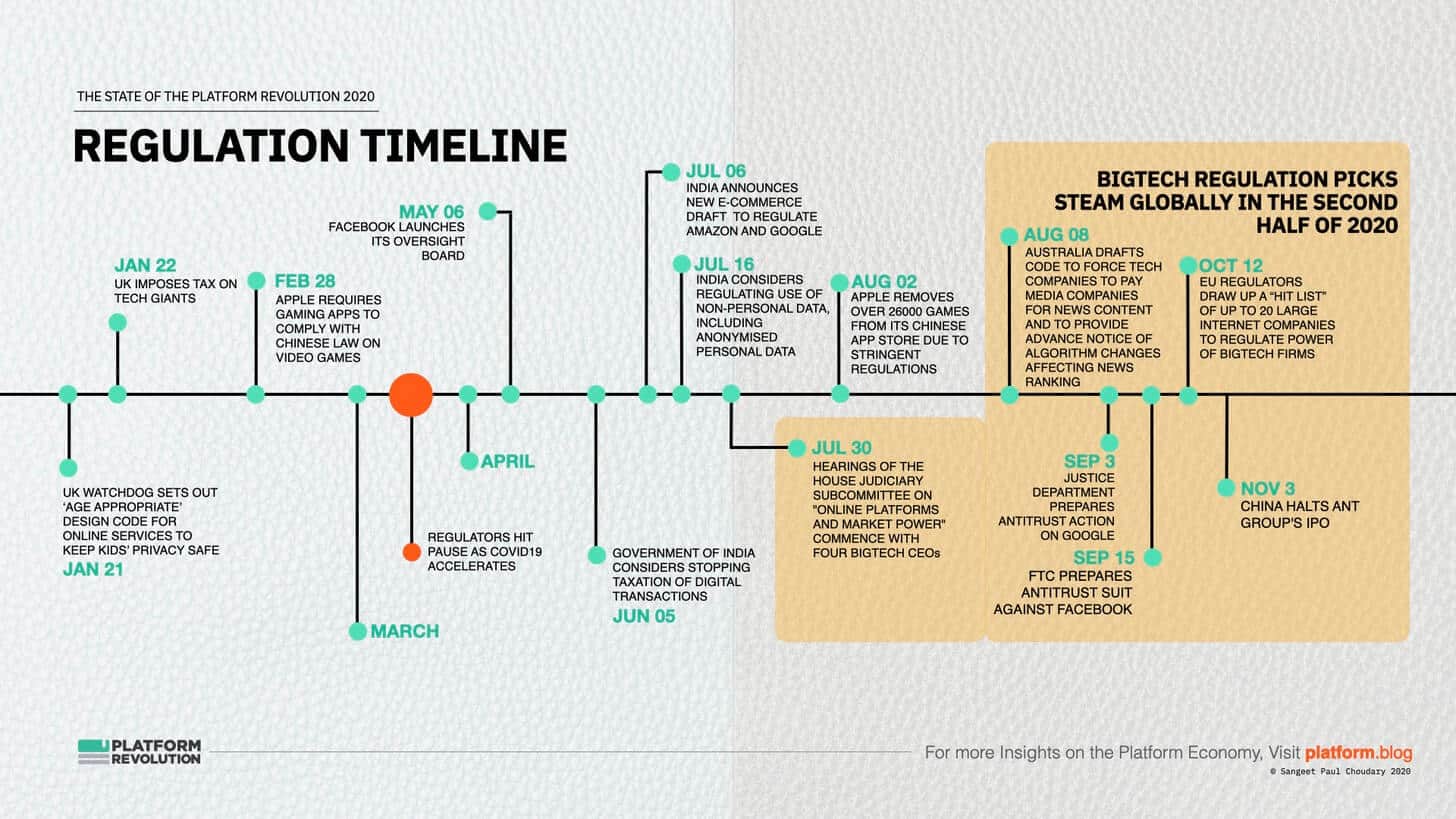Competition
The K-shaped recovery of the platform economy
Examining the increasing platform inequality
A Growing Divide in the K-Shaped Recovery
In one of the last issues we looked at China’s country-as-a-platform strategy. The below timeline traces China’s many moves in smart cities even as Huawei gets banned across the world.

2020 was the year when we worked across the alphabet in our attempts to explain how the economy would recover from the pandemic. It is now increasingly believed that the pandemic further exacerbated inequality, leading to, what some call a K-shaped recovery, where “different parts of the economy recover at different rates, times, or magnitudes.”
One of the most visible manifestations of this K-shaped recovery is the increasing divergence in the platform economy. While platform businesses didn’t just recover but soared to new valuation heights, the workers in many of these platforms’ ‘ecosystems’ were increasingly commoditized and disenfranchised. Worker classification as contractors coupled with increasing algorithmic control of their work leaves them with the worst of both worlds. Platform work often combines the constraints of employed work (lack of free agency) with the disadvantages of being an independent contractor (poor access to benefits).
This is a topic I’ve looked at extensively over the years, particularly as part of my work with the International Labor Organization and while advising several member states of the EU on the topic of platform work. Below, we look at many of the arguments that explain the increasing inequality in the platform economy as we ride this K-shaped recovery.
A framework for worker empowerment in the platform economy
To determine whether workers are empowered or exploited in the platform economy, I propose five possible criteria:
- Removal of free agency: Free agency is central to empowerment and entrepreneurship. By removing free agency, platforms take power away from workers, making it more likely that workers may be exploited for the functioning of an efficient market on the platform or even for the platform’s gains.
- Reduced bargaining power and rights: If a platform’s design and policies take bargaining power and rights away from the worker, the worker is more likely to be exploited.
- Domination: If a platform’s policies make workers subservient to the platform, the platform can use its superior position to exploit the workers.
- Dependence: If a platform’s design decisions make workers dependent on the platform and effectively locked in, preventing them from switching to other platforms, the workers are more susceptible to being exploited by the platform.
- Fairness: A platform that does not allocate risks and rewards fairly across the ecosystem exploits those workers who are forced to take on higher risks or aren’t rewarded sufficiently.
The K-shaped actors: Above-the-algorithm vs below-the-algorithm workers
Above-the-algorithm workers – Programmers and coders in the platform company – have access to a wide range of data flows about the ecosystem and analyze these data flows to inform the design of algorithms that manage the ecosystem. This allows platform programmers to alter the working of the algorithms to optimize market outcomes by studying below-the algorithm workers – drivers, food delivery agents etc – and their behavior, and imposing specific policies in response, either as explicit policies or encoded into their algorithms. These interventions have also been observed in other markets mediated by platforms.
However, the workers who are managed by these algorithms have near-zero visibility into the working of these algorithms. Workers would benefit from understanding the variables prioritized by an algorithm, but are not given such visibility. While the platform company can alter its algorithms in response to worker behavior, workers find it much more difficult to appropriately adjust their behavior in response to changes in the platform’s algorithms. This information asymmetry further empowers the platform and disempowers workers. Even if workers figure workarounds, the platform’s algorithms can track changes in behavior patterns to identify such workarounds and render them ineffective. Feedback by Postmates workers on online forums also indicates that workers see a divide between above-the-algorithm and below-the-algorithm workers.
Commoditization drives inequality
On work platforms, the more low-skilled and commodified the work that is exchanged, the more inelastic the workers tend to be. This is partly explained by the fact that low-skilled and commodified work may be performed by a much larger worker base. Hence, in the case of commodified work, the power balance shifts significantly away from workers. These platforms can create sustainable business models even with high churn of workers, resulting from workers leaving the platform when they feel exploited. For example, 20-40% of new workers would become inactive within 60-90 days of joining the cleaning services platform Handy.
Platforms, like Amazon Mechanical Turk, Postmates and FoodPanda (a food delivery platform) that facilitate exchange of low-skilled work may also find it easier to grow the network of workers rather than manage the concerns of existing workers. When the cost of nurturing the worker is higher than the cost of replacing them, the platform is likely to focus its efforts on network growth rather than on network management to combat churn.
On the other hand, high-skilled workers tend to be much more elastic and possess higher bargaining power with the platform, owing to the relative scarcity of such skills. They cannot afford high churn among their workers and are likely to create policies that are more worker-friendly.
Low-skilled workers, especially those who are unemployed, are also likely to be more dependent on the platform as their primary source of income. In contrast, high-skilled workers, especially those in information services, may use a platform to supplement other sources of income, or may participate across multiple platforms, thereby being less susceptible to exploitation owing to the policy changes of a particular platform.
Owing to this characteristic of two-sided markets, platforms – especially those that mediate commodified work exchange – tend to subsidize the participation of consumers, both through economic incentives and more favorable policies, and may be less focused on the success of workers on the platform, especially when it doesn’t directly impact outcomes for consumers.
Qualitative studies of drivers reveal that while Uber acts as the arbiter of disputes between drivers and passengers, drivers feel that Uber tends to favor passengers in these disputes.
Some platform policies may also work to create a superior experience for consumers while passing on the costs to workers. For example, Uber does not pay drivers for the time and effort in returning objects that passengers forget to take with them after a ride. While this improves the consumer experience, it passes on a cost to drivers that they can rarely negotiate, especially as this is communicated to them on a case-by-case basis, thereby preventing them from organizing action in protest.
This is also observed on Amazon Mechanical Turk where consumers of work can choose not to pay for work if not satisfied but can use the output of the work anyway. Again, the platform favors clients over commodified workers.
Even on platforms like UpWork where the work exchanged is not entirely substitutable or commodified, workers may be required to bid in a competitive auction-style system, encouraging a race to the bottom.
Some platforms are designed to encourage workers to compete against each other with only the winning worker being compensated. 99Designs, for instance, started out with a model where designers created competing designs based on an initial brief. On such platforms, only the winning designer – the one whose design is selected by the platform owner – gets compensated for the work. This works very well for clients who can benefit from the creations of multiple designers before choosing the one they like, but requires every participating designer, except the winner, to bear the cost of unpaid work.
Reputation systems also lead to greater power imbalance between consumers and workers. On ride-hailing platforms like Uber and Lyft, drivers need to maintain a high rating to be on the platform but there is no such stringent requirement on the consumer side. This effective management of workers by consumers gets complicated further when consumers do not effectively differentiate between platform liability and worker liability while giving feedback. For example, a consumer disgruntled with a poor app experience may leave a low rating for the worker, while rating his overall experience, irrespective of whether the platform or the worker were responsible for the experience.
As the more valuable and more elastic side, consumers are also favored by platform policies.
One final note on commodification. Platforms can themselves drive commodification of workers and make them more substitutable, even for high value work. This is already being observed among retail workers. Some retail management technologies require store workers to input information about customer preferences to provide shoppers a highly personalized experience and support workers in serving shoppers. However, by externalizing the information that workers used to serve customers, these systems make retail workers more substitutable and reduce their bargaining power with the firm. In this manner, new data-ingesting technologies can reduce the power of workers by making them more substitutable.
If you’d like to learn more about our work here, visit our Advisory page or request our Advisory kit to get more details on our analysis and approach.
For all the doom and gloom of 2020, a few important developments through the year have begun to shift the balance back in favor of workers.
Feel Free to Share
Download
Download Our Insights Pack!
- Get more insights into how companies apply platform strategies
- Get early access to implementation criteria
- Get the latest on macro trends and practical frameworks
Control without ownership
Till very recently, Platforms like Uber and Deliveroo would set the price for all workers, removing any form of bargaining power from the workers. Transportation platforms also determine the route that drivers must take, further reducing their free agency. This route setting also allows the platform to exercise greater control as the platform can require drivers to stick to the recommended route, even if it isn’t the most optimal one in that particular instance, e.g. due to current weather or traffic conditions. Lyft even instructs drivers how to greet passengers in line with the platform’s brand. Deliveroo schedules shifts for its couriers, which they agree to a week ahead. It also requires them to work at least two of the three evenings of Friday, Saturday or Sunday. These policies prevent workers from working on their own terms.
Ride-sharing platforms limit free agency by reducing choice for drivers. While platforms like Uber provide drivers access to requests for rides, they would often prevent them from making an informed choice on which rides to take on and which ones to reject. At the time of accepting a ride, the driver would not know the destination of the trip, and hence, would need to commit to a ride without knowledge about the renumeration involved. This gets further exacerbated because drivers with low ride acceptance rates or high cancellation rates are removed from the system.
uberPool provides another example of control through policies that limit choice for drivers. uberPool’s design illustrates, yet again, the relative importance of passengers in the ecosystem and the subsidies that the platform provides to attract them. Passengers pay lower for UberPool but the value for drivers is not as obvious. Drivers on UberPool need to pick up multiple passengers at different points, leading to a poor experience for passengers who get delayed owing to multiple pick-ups and may leave poor ratings for the driver. If uberPool was merely an intermediary, drivers would have the choice to withdraw from transactions at will. However, Uber doesn’t allow drivers to opt out of uberPool. Drivers, who are offered payment guarantees on Uber based on high acceptance rates of rides, are required to maintain those high acceptance rates for uberPool as well. Hence, drivers who want to drive for Uber but not for uberPool do not have a choice. The less attractive uberPool rides are effectively bundled with the more attractive premium rides. Drivers who turn down ride requests also risk getting temporarily locked out of the overall platform, another form of domination that would not exist in a free market setting.
Deliveroo’s platform design choices and policies limit choice for workers in a similar manner. The platform requires workers to respond to new orders within 30 seconds and the only option presented is “Accept delivery”. The delivery address is not revealed until the food is collected from the restaurant, at which point the only way to cancel the order is by contacting the driver support line directly. Any refusal to deliver at this point is also marked and works against the worker’s reputation.
Platforms often bait workers with guaranteed hourly wages, better consumer-side pricing, or lower commissions in order to gain their participation and guarantee a successful experience for consumers in the initial days. However, once these platforms start benefiting from network effects, they switch to policies that make the platform more profitable and sustainable.
During its initial launch, UberEats offered workers a pay of £20 an hour. As the platform gathered network effects and workers began to depend on the platform more, owing to greater consumer demand, the platform changed its worker incentive to a more complex formula involving £3.30 per delivery plus £1 per mile plus a £5 “trip reward”, not counting the 25% transaction cut that Uber levied. There was another change subsequently that revised the “trip reward” to £4 on weekday lunches and weekend dinners, and to £3 for weekday dinners and weekend lunches. Any delivery outside these periods didn’t offer a “trip reward”. Deliveroo also initially launched with a per-hour wage mechanism in London, where couriers were paid £7 an hour plus £1 a delivery, tips and petrol. It subsequently moved to a per-delivery fee of £3.75.
Uber’s competitor Lyft has also made frequent changes to its pricing and incentive mechanism, often in response to Uber’s pricing. For example, the platform dropped fares by 30 percent in several cities to respond to Uber, and instead created new incentives that rewarded the most active drivers, reducing its transaction cut to 5% for drivers putting in 40-50 hours of work in a week while removing the cut altogether for those who worked more. While this change in policy does reward the workers who work the most, it still works as a policy change that impacts the majority of workers negatively.
Finally, ride-hailing and delivery platforms also leverage metrics-based feedback to ensure that workers maintain a high acceptance rate and a low cancellation rate, failing which the workers risk deactivation. These platforms may also disincentivize workers who do not perform a minimum number of tasks or rides on a particular day by charging a higher transaction cut, as mentioned earlier in this paper in the case of Lyft. If drivers on Uber miss accepting three rides in a row, they are temporarily deactivated. Deliveroo sends customised monthly reports to workers laying out a host of other metrics, including average “time to accept orders”, “travel time to restaurant”, “travel time to customer”, “time at customer”, “late orders” and “unassigned orders”. The platform also compares the worker’s performance to a standard threshold set by the platform for every metric.
Regulating power back to workers
For all the doom and gloom of 2020, a few important developments through the year have begun to shift the balance back in favor of workers.
First, as Covid19 raged and lockdowns put restaurants out of business, many cities in the US ruled that the transaction fee captured by delivery platforms from restaurants would be capped at 15%. This ensured that restaurants, which were more than ever dependant on these delivery platforms, could survive the pandemic without having their margins squeezed.
Next, Uber changed its rules in California to show drivers the details of their ride before requiring them to accept it. A step in the right direction, this points to a possibility that other jurisdictions may soon roll out similar requirements.
Third, platforms like Uber have also started allowing drivers to set their rates in some geographies.
Finally, an increasing number of jurisdictions around the world ruled to consider some types of gig economy workers as full time employees, not contractors, and recognized their rights to social benefits.
Finally, The platform economy moving forward…
The K-shaped recovery of the platform economy is one of the key themes discussed in detail in our report on the platform economy.


State of the Platform Revolution
The State of the Platform Revolution report covers the key themes in the platform economy in the aftermath of the Covid-19 pandemic.
This annual report, based on Sangeet’s international best-selling book Platform Revolution, highlights the key themes shaping the future of value creation and power structures in the platform economy.
Themes covered in this report have been presented at multiple Fortune 500 board meetings, C-level conclaves, international summits, and policy roundtables.
Subscribe to Our Newsletter











